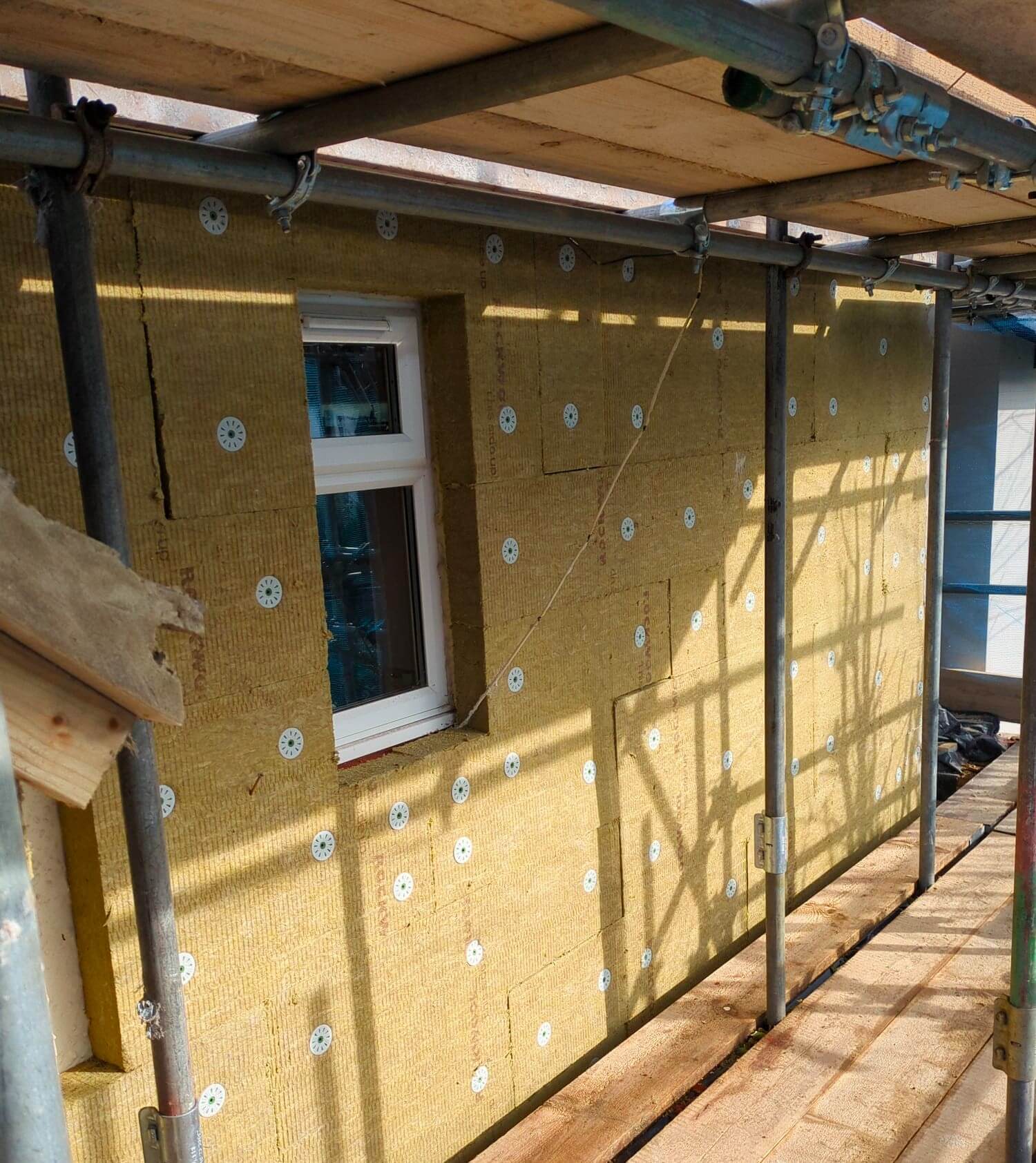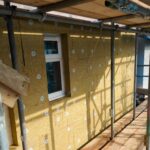In CWI, EEM, EWI, GFI, IWI, Retrofit by Robert Wheeler / 12 June 2024 / 0 comments

Retrofitting in construction is a crucial process that involves upgrading existing buildings or structures to meet modern standards of safety, energy efficiency, and functionality.
This blog post explores the concept of retrofitting, its importance, various techniques used in the industry, factors to consider before undertaking a retrofit project, real-world case studies showcasing successful retrofitting endeavours, challenges faced during the retrofit process, and future trends in retrofitting technology. Understanding the significance and intricacies of retrofitting is essential for ensuring the longevity and sustainability of our built environment.
Introduction to Retrofitting in Construction
Retrofitting in construction is like giving your building a makeover to keep up with the times. It’s like upgrading from a flip phone to a smartphone – making improvements to an existing structure rather than starting from scratch.
Definition of Retrofitting
Retrofitting is the process of adding new features or technology to older systems to enhance performance, efficiency, or safety. It’s all about bringing a building up to current standards and making it more sustainable for the future.
Historical Context
Retrofitting has been around for ages – think of it as giving your grandma’s antique dresser a fresh coat of paint and new handles. Buildings, just like furniture, need updates and enhancements to stay functional and relevant in today’s world.
Importance and Benefits of Retrofitting
Retrofitting isn’t just about making things look prettier – it serves some crucial purposes that can make a big difference in the long run.
Enhancing Structural Integrity
One of the main reasons for retrofitting is to strengthen the structure of a building, especially in earthquake-prone areas. It’s like giving your house a set of invisible armour to protect it from potential disasters.
Improving Energy Efficiency
Retrofitting can also help make a building more energy-efficient by upgrading insulation, windows, and HVAC systems. It’s like giving your home a green makeover, saving you money on energy bills and reducing your carbon footprint.
Types of Retrofitting Techniques
Retrofitting comes in different flavours, each tailored to address specific needs and challenges of a building.
Seismic Retrofitting
Seismic retrofitting focuses on strengthening buildings to withstand earthquakes. It’s like giving your house a crash course in tectonic plates and making sure it can shake, rattle, and roll without falling apart.
Energy Retrofitting
Energy retrofitting involves upgrading a building’s systems to reduce energy consumption and improve sustainability. It’s like giving your home a high-tech energy makeover, turning it into a lean, green, energy-saving machine.
Facade Retrofitting
Façade retrofitting involves improving the external appearance and functionality of a building. It’s like giving your house a stylish new outfit that not only turns heads but also provides better weather protection and insulation.
Factors to Consider Before Retrofitting
Before diving into a retrofitting project, there are a few key factors to keep in mind to ensure a successful and cost-effective outcome.
Structural Assessment
First and foremost, a thorough structural assessment is essential to identify areas that need attention and determine the best retrofitting solutions. It’s like getting a building’s DNA test to understand its weaknesses and strengths.
Budget and Cost Considerations
Retrofitting can be a worthwhile investment in the long term, but it’s crucial to set a realistic budget and consider the costs involved. It’s like deciding how much you’re willing to spend on that home renovation project – finding the right balance between quality and affordability.
Case Studies of Successful Retrofitting Projects
Example 1: Retrofitting a Historic Building
When it comes to preserving the charm of historic buildings while ensuring safety and efficiency, retrofitting plays a vital role. The successful retrofitting of a historic building showcases how modern technology and techniques can be integrated seamlessly with traditional architecture. This not only enhances the building’s structural integrity but also maintains its historical significance for future generations to appreciate.
Example 2: Retrofitting a Commercial Property
Retrofitting a commercial property is a smart investment that can lead to significant energy savings and improved sustainability. By implementing energy-efficient systems and technologies, such as lighting upgrades, HVAC improvements, and insulation enhancements, commercial properties can reduce operational costs and minimize their carbon footprint. A successful retrofitting project for a commercial property demonstrates the positive impact on both the environment and the bottom line.
Retrofitting Challenges and Solutions
Technical Challenges
One of the main technical challenges in retrofitting construction is integrating new systems with existing structures seamlessly. This requires careful planning, coordination, and expertise to ensure that the retrofit does not compromise the building’s safety or functionality. Innovative solutions, such as modular components and building information modelling (BIM), can help overcome technical challenges and streamline the retrofitting process.
Regulatory Constraints
Navigating regulatory requirements and compliance standards can be a significant challenge in retrofitting projects. Building codes, zoning regulations, and permit approvals can impact the design and implementation of retrofitting solutions. Working closely with regulatory authorities and engaging with stakeholders early in the project can help address regulatory constraints effectively and ensure compliance with applicable laws and standards.
Future Trends in Retrofitting Technology
Innovative Materials and Methods
The future of retrofitting technology is bright, with innovative materials and methods continuously being developed to enhance building performance and sustainability. From advanced insulation materials to seismic retrofitting techniques, the use of cutting-edge technology is revolutionizing the retrofitting industry. Embracing these innovative materials and methods can lead to more efficient and cost-effective retrofitting solutions for diverse construction projects.
Advancements in Retrofitting Software
Technology plays a crucial role in streamlining the retrofitting process, and advancements in retrofitting software are making project management more efficient and transparent. With the increasing use of building information modelling (BIM) software, project teams can collaborate effectively, visualize design concepts, and simulate construction scenarios before implementation. The integration of artificial intelligence (AI) and virtual reality (VR) technologies is also shaping the future of retrofitting software, offering new possibilities for enhancing project outcomes and client satisfaction.
Conclusion
In conclusion, retrofitting in construction plays a vital role in ensuring the resilience and sustainability of our existing built environment. By embracing innovative techniques, addressing challenges, and staying updated on emerging trends, we can effectively enhance the safety, efficiency, and longevity of buildings for generations to come. Retrofitting not only transforms structures but also contributes to a more resilient and sustainable future for our communities.
FAQs About Retrofitting in Construction
Retrofitting is the process of upgrading existing buildings or structures to meet modern standards of safety, energy efficiency, and functionality. It’s like giving your building a makeover, but with a focus on functionality and long-term benefits.
There are several reasons why retrofitting is important:
Enhances structural integrity: Retrofitting can strengthen buildings against earthquakes and other natural disasters.
Improves energy efficiency: This can save money on energy bills and reduce environmental impact.
Extends the lifespan of buildings: Retrofitting can prevent buildings from becoming outdated or obsolete.
Preserves historic buildings: Retrofitting allows us to maintain the character of historic buildings while upgrading them to meet modern safety standards.
Some common types of retrofitting include:
Seismic retrofitting: Strengthens buildings against earthquakes.
Energy retrofitting: Improves energy efficiency through upgrades to insulation, windows, and HVAC systems.
Façade retrofitting: Improves the external appearance and functionality of a building’s exterior.
Structural assessment: A thorough evaluation is needed to identify areas that need improvement and determine the best solutions.
Budget and cost considerations: Retrofitting can be a good investment, but setting a realistic budget is crucial.
Technical challenges: Integrating new systems with existing structures can be complex.
Regulatory constraints: Building codes and permits can impact the design and implementation of retrofitting solutions.
Innovative materials and methods: New insulation materials and seismic retrofitting techniques are constantly being developed.
Advancements in retrofitting software: Building information modelling (BIM) software is improving project management and design.
The blog post mentions two examples:
Retrofitting a historic building to preserve its charm while ensuring safety and efficiency.
Retrofitting a commercial property to achieve significant energy savings and improved sustainability.
These examples showcase the positive impact retrofitting can have on different types of buildings.
Ready to discuss your regeneration project and how NXTGEN Futures Ltd can elevate it with expert retrofit? Contact us today!
Latest Retrofit Posts
- What a retrofit-first approach offers the UKRetrofitting is like giving your home a makeover to make it more energy-efficient, comfortable, and healthy. The retrofit-first approach prioritizes upgrading existing buildings over new construction to tackle climate change and improve living conditions. Definition of Retrofitting Retrofitting involves making… Read more: What a retrofit-first approach offers the UK
- What is internal wall insulation?Internal wall insulation is a crucial component of creating a comfortable and energy-efficient living space. By insulating the walls within a building, homeowners can experience benefits such as improved thermal performance, reduced energy bills, and enhanced acoustic comfort. Understanding the… Read more: What is internal wall insulation?
- What is a retrofit assessor?Retrofit assessors play a crucial role in the sustainability and energy efficiency of buildings by evaluating and identifying opportunities for improvement. This blog post aims to provide an in-depth understanding of the responsibilities, qualifications, and benefits associated with being a… Read more: What is a retrofit assessor?
- What is a retrofit assessment in the UK?Retrofit assessments play a crucial role in the sustainable development of buildings in the UK, helping to improve energy efficiency, reduce carbon emissions, and enhance overall building performance. By evaluating existing structures and identifying opportunities for upgrades and enhancements, retrofit… Read more: What is a retrofit assessment in the UK?
- Retrofit and Energy Efficiency in Historic BuildingsHistoric buildings are not only architectural treasures but also valuable cultural assets that contribute to our sense of history and identity. However, many of these buildings often suffer from poor energy efficiency, leading to excessive energy consumption and high operating… Read more: Retrofit and Energy Efficiency in Historic Buildings
- What is retrofitting in construction?Retrofitting in construction is a crucial process that involves upgrading existing buildings or structures to meet modern standards of safety, energy efficiency, and functionality. This blog post explores the concept of retrofitting, its importance, various techniques used in the industry,… Read more: What is retrofitting in construction?
- CASE STUDY: Curtis WayDelivering a Holistic Retrofit Solution with EWI & Solar Energy Project Overview NXTGEN Futures Ltd. successfully completed a large-scale retrofit project on Curtis Way, Berkhamsted, England, UK. This case study showcases our expertise in External Wall Insulation (EWI), retrofit coordination,… Read more: CASE STUDY: Curtis Way
- What happens to a building during retrofitting?Building retrofitting is a vital process that involves making significant modifications and improvements to existing structures to enhance their efficiency, functionality, and sustainability. In this blog post, we will delve into the intricate workings of building retrofitting, exploring the various… Read more: What happens to a building during retrofitting?
- UK Government Retrofit Scheme: Making Energy Efficiency Cool AgainIntroduction to the UK Government Retrofit Scheme Background of the Retrofit Scheme Picture this: you’re sitting at home, snuggled up in your favourite blanket, enjoying a cup of tea, when suddenly you feel a draft. Not cool, right? Well, that’s… Read more: UK Government Retrofit Scheme: Making Energy Efficiency Cool Again
- What are Retrofit Trickle Vents?Improving indoor air quality and enhancing energy efficiency are key priorities for many homeowners. In this article, we will explore the concept of retrofit trickle vents and their role in achieving these goals. Trickle vents are small, adjustable openings integrated… Read more: What are Retrofit Trickle Vents?
- Retrofit Underfloor HeatingRetrofit underfloor heating has gained significant popularity as a cost-effective and efficient solution for enhancing the comfort and energy efficiency of existing buildings. Unlike traditional radiator systems, underfloor heating distributes warmth evenly across the floor, providing a comfortable and cozy… Read more: Retrofit Underfloor Heating
- Retrofit LondonRetrofitting has emerged as a crucial solution in transforming the landscape of cities, and London is no exception. As a global hub of culture, commerce, and innovation, London faces the pressing challenge of reducing its carbon footprint while ensuring sustainable… Read more: Retrofit London












